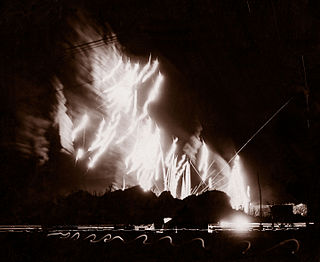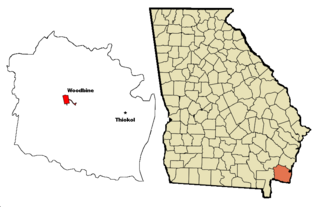This article needs additional citations for verification .(March 2008) |
A driptorch is a tool used in wildfire suppression, controlled burning, and other forestry applications to intentionally ignite fires by dripping flaming fuel onto the ground.
This article needs additional citations for verification .(March 2008) |
A driptorch is a tool used in wildfire suppression, controlled burning, and other forestry applications to intentionally ignite fires by dripping flaming fuel onto the ground.

The driptorch consists of a canister for holding fuel with a handle attached to the side, a spout with a loop to prevent fire from entering the fuel canister, a breather valve to allow air into the canister while fuel is exiting through the spout, and a wick from which flaming fuel is dropped to the ground. The wick is ignited and allows the fire to be directed as needed. The spout and wick can be secured upside down inside the canister for storage or transport. Typically the fuel used is a mixture of gasoline and diesel with a ratio of 30% to 70% respectively, although, the amounts may need to be adjusted according to fuel and weather conditions. [1] Sometimes heavier oils are used to increase adhesion of the liquid fuel to the vegetation, and increase burn time and heat.
Variations of the driptorch can be attached to off-road vehicles, such as tractors, to ignite a fire while driving slowly along the ignition line. Another variant of the driptorch is the helitorch , which is attached to a helicopter and is used to ignite fire from the air.
The intentional ignition of fires is a common firefighting tactic. A burnout (also called a firing operation, firing out or a back burn) is a smaller fire ignited along a control line ahead of the main fire. The intent is to consume fuel ahead of the main fire, strengthening the control line. A backfire is a more aggressive type of burning done to influence the behavior of the main fire.
In forest and prairie management, the driptorch is the most common tool used to ignite prescribed burns, which are used to remove excess fuel buildup or to re-create natural cycles of fire in an ecosystem. Other tools which can also be used for this purpose include the fusee, a pyrotechnic device similar to a road flare, other pyrotechnic devices, or even burning vegetative fuels.

A Molotov cocktail is a hand-thrown incendiary weapon consisting of a frangible container filled with flammable substances and equipped with a fuse. In use, the fuse attached to the container is lit and the weapon is thrown, shattering on impact. This ignites the flammable substances contained in the bottle and spreads flames as the fuel burns.

A flare, also sometimes called a fusée, fusee, or bengala, bengalo in several European countries, is a type of pyrotechnic that produces a bright light or intense heat without an explosion. Flares are used for distress signaling, illumination, or defensive countermeasures in civilian and military applications. Flares may be ground pyrotechnics, projectile pyrotechnics, or parachute-suspended to provide maximum illumination time over a large area. Projectile pyrotechnics may be dropped from aircraft, fired from rocket or artillery, or deployed by flare guns or handheld percussive tubes.

Pyrotechnics is the science and craft of creating such things as fireworks, safety matches, oxygen candles, explosive bolts and other fasteners, parts of automotive airbags, as well as gas-pressure blasting in mining, quarrying, and demolition. This trade relies upon self-contained and self-sustained exothermic chemical reactions to make heat, light, gas, smoke and/or sound. The name comes from the Greek words pyr ("fire") and tekhnikos.

A lighter is a portable device which creates a controlled flame, and can be used to ignite a variety of flammable items, such as cigarettes, butane gas, fireworks, candles, or campfires. A lighter typically consists of a metal or plastic container filled with a flammable liquid, a compressed flammable gas, or in rarer cases a flammable solid ; a means of ignition to produce the flame; and some provision for extinguishing the flame or else controlling it to such a degree that the user may extinguish it with their breath. Alternatively, a lighter can be one which uses electricity to create an electric arc utilizing the created plasma as the source of ignition or a heating element can be used in a similar vein to heat the target to its ignition temperatures, as first formally utilized by Friedrich Wilhelm Schindler to light cigars and now more commonly seen incorporated into the automobile auxiliary power outlet to ignite the target material. Different lighter fuels have different characteristics which is the main influence behind the creation and purchasing of a variety of lighter types.

Tracer ammunition, or tracers, are bullets or cannon-caliber projectiles that are built with a small pyrotechnic charge in their base. When fired, the pyrotechnic composition is ignited by the burning powder and burns very brightly, making the projectile trajectory visible to the naked eye during daylight, and very bright during nighttime firing. This allows the shooter to visually trace the trajectory of the projectile and thus make necessary ballistic corrections, without having to confirm projectile impacts and without even using the sights of the weapon. Tracer fire can also be used as a marking tool to signal other shooters to concentrate their fire on a particular target during battle.

The Space Shuttle Solid Rocket Booster (SRB) was the first solid-propellant rocket to be used for primary propulsion on a vehicle used for human spaceflight. A pair of these provided 85% of the Space Shuttle's thrust at liftoff and for the first two minutes of ascent. After burnout, they were jettisoned and parachuted into the Atlantic Ocean where they were recovered, examined, refurbished, and reused.

A controlled or prescribed (Rx) burn is the practice of intentionally setting a fire to change the assemblage of vegetation and decaying material in a landscape. The purpose could be for forest management, ecological restoration, land clearing or wildfire fuel management. A controlled burn may also refer to the intentional burning of slash and fuels through burn piles. Controlled burns may also be referred to as hazard reduction burning, backfire, swailing or a burn-off. In industrialized countries, controlled burning regulations and permits are usually overseen by fire control authorities.

In an explosive, pyrotechnic device, or military munition, a fuse is the part of the device that initiates function. In common usage, the word fuse is used indiscriminately. However, when being specific, the term fuse describes a simple pyrotechnic initiating device, like the cord on a firecracker whereas the term fuze is used when referring to a more sophisticated ignition device incorporating mechanical and/or electronic components, such as a proximity fuze for an M107 artillery shell, magnetic or acoustic fuze on a sea mine, spring-loaded grenade fuze, pencil detonator, or anti-handling device.
This glossary of wildfire terms is a list of definitions of terms and concepts relevant to wildfires and wildland firefighting. Except where noted, terms have largely been sourced from a 1998 Fireline Handbook transcribed for a Conflict 21 counter-terrorism studies website by the Air National Guard.

The United States Armed Forces has created a plethora of different types of 40 mm grenades in both the low-velocity 40×46 mm and high-velocity 40×53 mm calibers which uses what it calls a high-low propulsion system which keeps recoil forces within the boundaries of an infantry weapon. Presented on this page is a basic overview.

Smouldering or smoldering is the slow, flameless form of combustion, sustained by the heat evolved when oxygen directly attacks the surface of a condensed-phase fuel. Many solid materials can sustain a smouldering reaction, including coal, cellulose, wood, cotton, tobacco, cannabis, peat, plant litter, humus, synthetic foams, charring polymers including polyurethane foam and some types of dust. Common examples of smouldering phenomena are the initiation of residential fires on upholstered furniture by weak heat sources, and the persistent combustion of biomass behind the flaming front of wildfires.

An electric match is a device that uses an externally applied electric current to ignite a combustible compound.
A pyrotechnic composition is a substance or mixture of substances designed to produce an effect by heat, light, sound, gas/smoke or a combination of these, as a result of non-detonative self-sustaining exothermic chemical reactions. Pyrotechnic substances do not rely on oxygen from external sources to sustain the reaction.

Fire-retardant fabrics are textiles that are more resistant to fire than others through chemical treatment of flame-retardant or manufactured fireproof fibers.

A flare or decoy flare is an aerial infrared countermeasure used by an aircraft to counter an infrared homing ("heat-seeking") surface-to-air missile or air-to-air missile. Flares are commonly composed of a pyrotechnic composition based on magnesium or another hot-burning metal, with burning temperature equal to or hotter than engine exhaust. The aim is to make the infrared-guided missile seek out the heat signature from the flare rather than the aircraft's engines.
In pyrotechnics, a pyrotechnic initiator is a device containing a pyrotechnic composition used primarily to ignite other, more difficult-to-ignite materials, such as thermites, gas generators, and solid-fuel rockets. The name is often used also for the compositions themselves.
A pyrotechnic heat source, also called heat pellet, is a pyrotechnic device based on a pyrotechnic composition with a suitable igniter. Its role is to produce controlled amount of heat. Pyrotechnic heat sources are usually based on thermite-like fuel-oxidizer compositions with slow burn rate, high production of heat at desired temperature, and low to zero production of gases.

The Thiokol-Woodbine explosion occurred at 10:53 a.m. EDT on Wednesday, February 3, 1971, at the Thiokol chemical plant, 12 miles (19 km) southeast of Woodbine, Georgia, and 30 miles (48 km) north of Jacksonville, Florida, when large quantities of flares and their components in building M-132 were ignited by a fire and detonation occurred. A total of 29 workers died.

This is an alphabetized glossary of terms pertaining to lighting fires, along with their definitions. Firelighting is the process of starting a fire artificially. Fire was an essential tool in early human cultural development. The ignition of any fire, whether natural or artificial, requires completing the fire triangle, usually by initiating the combustion of a suitably flammable material.

A magnesium torch is a bright light source made from magnesium, which can burn underwater and in all weather conditions. They are used for emergency illumination for railroad applications. They were also used in the 1950s up to the early 1970s as a light source for scuba diving, and were featured occasionally in television shows. A relay of magnesium torches was used to transfer the Olympic flame from Greece to the site of the Olympic games several times since the first occasion at the 1936 Berlin Games.